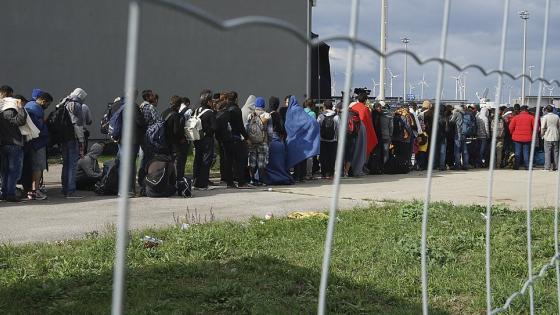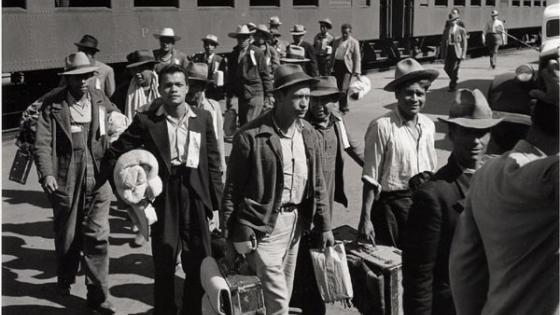The phenomenon of workers moving from a poor to a rich economy, whether internally or across countries, is a very prevalent one. It also is a salient issue, with such migration flows very high on the political agenda in many rich countries. When a worker moves to an economy richer than the home economy, what are the gains?
It has been argued that the migrant gains from such a move are very large. For example, Kennan (2013) estimates a gain in net income of 125% in a model of migrants from poor countries to rich ones. This view is reinforced by findings in the literature, with large cross-country differences in GDP per capita and wages.
Moreover, D'Amuri and Peri (2010) note that immigrants do not harm the wages and job prospects of native workers. They explain that there is large scope for complementarities between foreign-born and native workers.
It is not straightforward, however, to answer the question of the gains and costs of worker migration from poor to rich countries. The difficulty is related to the need to disentangle the effects of income differences on movers’ decisions from many other determinants of such mobility. The set of determinants includes geographical distance, socio-demographic factors (including family linkages and social networks), credit constraints, welfare benefits, insurance motives, psychological issues, and more. Many estimates in the literature are potentially biased due to the omission of relevant determinants, often because data are unavailable.
In a recent paper (Yashiv 2021), I study a case that allows me to isolate the pure effects of cross-country income differences. The data set consists of Palestinian workers who were working in Israel and in the local economy. During most of the 1980s, a sizeable fraction of the male labour force from Palestine worked in Israel, a far richer economy. The features of this labour market were such that the other cited determinants of migration played no role. Workers could decide to work in a richer economy and get there via a daily or weekly commute. Without the confounding factors, the decision to work in the rich economy can be estimated without bias. Furthermore, capital and productivity differences between Israel and Palestine were sufficiently high so as to conform with well-documented differences between rich and poor countries typically not found within a single country. At the same time, the relatively short distances facilitated a low-cost move from the poor to the rich economy.
Underlying the analysis of these data is the distinction between factors external to the worker (such as technology, capital, and institutions) and factors embodied in the worker (such as skills and abilities). Hence, when estimating wage equations in order to infer the gains of the move from a poor to a rich economy, I explicitly address the question of what workers experience in the richer economy (say, a higher technology level), what is taken from the poor economy (skills), and their choices in moving (self-selection).
Importantly, I take into account the fact that movers and stayers are typically constrained in terms of the job tasks offered to them and the skills required. I recognise that workers face particular job task requirements and wage rewards for their skills in performing these tasks. Workers are demanded for a specific task, utilising a bundle of skills, rewarded in a specific way, in each location – the poor home economy and the rich host economy.
My findings are that relatively low task returns, offered to the migrants in the rich economy, substantially offset the productivity gain for these migrants stemming from the rich economy having higher levels of technology and capital. This can be seen by noting the following two effects:
(1) The move from Palestine to Israel generated an increase in wages, i.e. there was a ‘moving premium’. The increase resulted in this component of wages being between 1.6 and 3 times higher in Israel across sample years. The reason for this is that Israel has higher levels of technology and capital.
(2) The Palestinian economy offered higher returns to skills such as education and experience. This operated to lower migrants’ wages. This effect made this component of local wages in Palestine 1.8 to 2. 7 times higher.
Hence effect (1) offsets effect (2).
How can one account for the fact that the returns to the same skills differ markedly for movers and stayers? The local economy rewarded education and experience substantially more, which can be explained by looking more closely at the types of jobs in each economy. Local employment in Palestine was characterised by industries and occupations that presumably require the performance of more analytical tasks. In particular, government, personal, and financial services account for about 40% of local employment. In contrast, in Israel employment was highly concentrated (over 80%) in three industries – construction, manufacturing, and agriculture – typically requiring manual tasks. In terms of occupations, 19% of local workers were employed in high-skilled occupations versus 1% in such occupations in Israel. So it is not surprising that local employment offered higher returns for education and experience.
The task perspective is relevant for many cases of foreign minorities in advanced economies. Often, workers belonging to such minorities are asked to perform low-skill tasks. In a review of migration, productivity, and the labour market, Peri (2016) emphasises the importance of recognising the role of tasks performed by migrants, especially manual tasks. He references studies documenting this widespread phenomenon, showing that employment in manual low-skill occupations is a salient feature.
My contribution may be better understood when noting that the academic literature often looks at the move from poor to rich economies (1) without disentangling the income differences motive from other motives, and (2) anticipating a big productivity gain due to the rich economy having higher TFP and capital. Here I show that with respect to point (1), there is a high risk of substantial misspecification and bias, while the unique data set used here eschews such bias. With respect to point (2), my paper emphasises the idea that tasks are tied to locations, and so workers choose a location-task-wage ‘pack’ which determines rewards to the skills bundled in the job task. The low rewards for tasks actually offered to movers generate a substantial offset to the productivity gain.
References
D'Amuri, F and G Peri (2010), "Immigration and Productive Tasks: Can Immigrant Workers Benefit Native Workers?" VoxEU.org, 31 October.
Kennan, J (2013), "Open Borders," Review of Economic Dynamics 16: L1-L13.
Peri, G (2016), "Immigrants, Productivity, and Labour Markets," Journal of Economic Perspectives 30(4): 3-30.
Yashiv, E (2021), "Moving from a Poor Economy to a Rich One: A Job Tasks Approach," CEPR Discussion Paper 16214 (forthcoming in Labour Economics).



